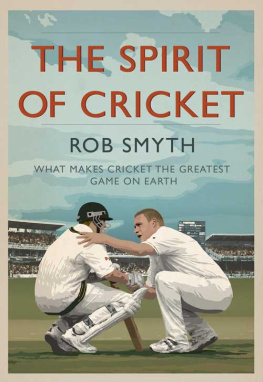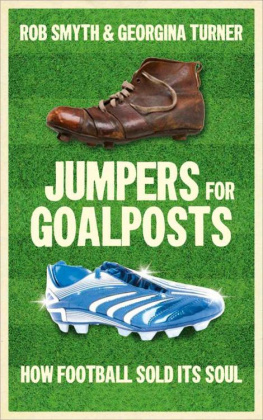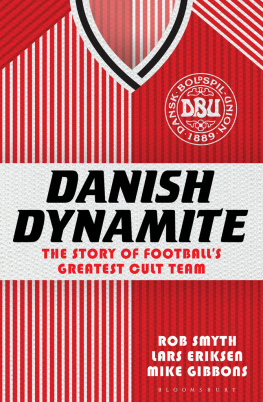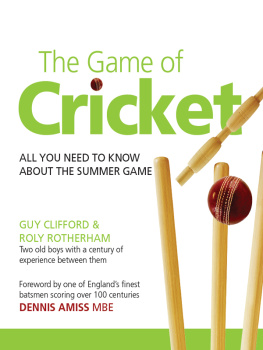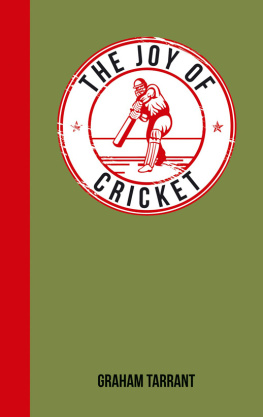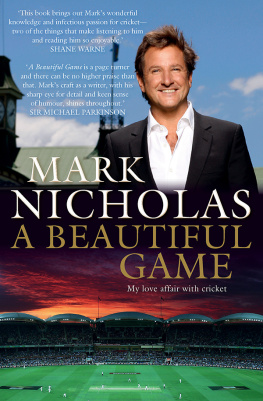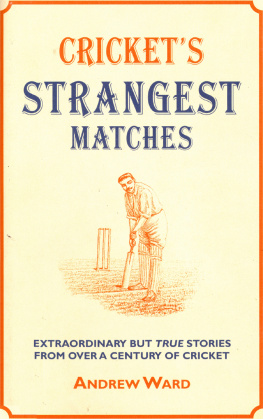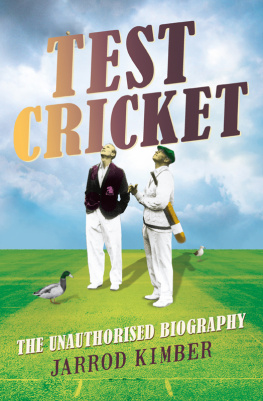THE SPIRIT
OF CRICKET
ROB SMYTH
WHAT MAKES CRICKET THE GREATEST GAME ON EARTH

First published 2010 by Elliott and Thompson Limited
27 John Street, London WC1N 2BX
www.eandtbooks.com
ISBN: 978-1-90764-212-8
Copyright Rob Smyth 2010
This edition published in 2010
The right of the authors to be identified as the authors
of this work has been asserted by them in accordance with the
Copyright, Designs and Patents Act 1988.
All rights reserved. No part of this publication may be
reproduced, stored in or introduced into a retrieval system,
or transmitted, in any form, or by any means (electronic, mechanical,
photocopying, recording or otherwise) without the prior written
permission of the publisher. Any person who does any unauthorized
act in relation to this publication may be liable to criminal
prosecution and civil claims for damages.
9 8 7 6 5 4 3 2 1
A CIP catalogue record for this book is available from the British Library.
Printed in the UK by CPI Group
The contributions from Michael Brearley and Sir Richard Hadlee were first published by The International Cricket Council.
Every effort has been made to trace copyright holders for extracts used within this book. Where this has not been possible the publisher will be happy to credit them in future editions.
ACKNOWLEDGMENTS
There are so many people who helped with this book the majority of whom I have not even met, only admired as they went to work on a cricket field that it is impossible to list them all. And Im not only saying that to cover myself in the inevitable event of forgetting somebody important. I owe a particular debt of gratitude to Lorne Forsyth, Ellen Marshall, Cris Freddi, Scott Murray, Gary Naylor, Richard OHagan, Paul King, James Henderson and Adam Chadwick.
The contributors, amongst them some of the true greats of the game, were remarkably generous with their time: Richie Benaud, Dickie Bird, Sir Ian Botham, Michael Brearley, Andy Bull, Alan Davies, Duncan Fletcher, David Gower, Tony Greig, Sir Richard Hadlee, Michael Holding, Nasser Hussain, Mahela Jayawardene, Mitchell Johnson, Jacques Kallis, Robert Key, David Lloyd, Christopher Martin-Jenkins, Sam Mendes, Alison Mitchell, Eoin Morgan, Mark Nicholas, Ricky Ponting and Graeme Smith. It is purely coincidental that the list ends at S. I never did manage to track down Kapila Wijegunawardene.
Id especially like to thank John English for his skilful editing, and Mark Searle for his advice and ceaseless patience, particularly every time the phone cut out while one of us was on a train. Finally Id like to thank Dr Colin Butler for introducing me to the joy of words; Tim de Lisle for introducing me to the joy of writing; my father, John, for introducing me to the joy of sport; and my mother, Betty, for introducing me to the joy of life.
INTRODUCTION
W hen television cameramen cut to the crowd during a sporting event, they invariably focus on three types: the beautiful, the famous and the wacky. Yet when those cameras lingered, apparently inexplicably, on a random middle-aged woman during the final Ashes Test of 2009, it provided a different and infinitely more rewarding type of beauty.
The woman was desperately biting her clenched fist in an attempt to stop herself from haemorrhaging tears. This was not, as might reasonably have been presumed, the default setting of the England cricket fan during an Ashes series, but the reaction of Donna Trott to the sight of her son, Jonathan, reaching a glorious century on his Test debut.
Her attempt was doomed to failure, and tears of pride soon flowed. It was an extraordinary moment: in the midst of a monumental contest, the overriding emotion was of the wonderful poignancy of a mothers love for her son. It was the feelgood shot of the summer. In the context of such a fiercely contested sporting encounter, it was as incongruous as a lullaby in a heavy-metal song.
And yet in a sense it wasnt incongruous at all. Cricket has always had the capacity to transcend sport and, in that moment, the spirit of cricket and the spirit of life was in the rudest health. There are inherent contradictions in our understanding of the spirit of cricket. How could there not be? To one person the spirit of cricket would be embracing it as part of a rounded, cultured existence, as C. L. R. James did with his famous quote What do they know of cricket who only cricket know?; yet to another it might manifest itself in an all-consuming love of the sport.
Equally, in the current climate many will surmise that Twenty20 is against the true spirit of cricket, yet the issue is not a simple one. In its early guise it had an innocence and a celebration of the game itself over winning and losing that truly evoked crickets Golden Age; a hit-and-giggle philosophy which, at some level, resonated with the distant past. Similarly, after the inaugural World Cup in 1975, the umpire Dickie Bird said that It had everything. Such great players, and a freshness in spirit and approach that is not possible now.
To some the pervasion of statistics is against the spirit; yet even many of those who hold such a view could not fail to be charmed by the sight of a small boy scoring every ball diligently on an idyllic summers day. We can be at peace with these contradictions: cricket is a game which allows one of us to say tomay-to and the other to say tomah-to without ever feeling the need to call the whole thing off.
That which contravenes the spirit of cricket to one will embody it to another. The us-against-the-world captaincy of Arjuna Ranatunga manifested itself in a number of on-field contretemps, but in doing so he significantly accelerated the development of a cricket nation that currently provides more exceptional talents than any other.
Even within the accepted parameters of sportsmanship, there are contradictions. As Duncan Fletcher says, why is claiming a catch on the bounce seen as inherently reprehensible whereas not walking is widely acknowledged as part of the game?
The inevitable influence of national characteristics also serves to undermine a homogenised definition of the spirit of cricket. The same is true of eras. Our understanding of the concept has inevitably evolved; it seems remarkable now, but at the start of the 20th century it was emphatically the case that Test cricket was seen as being against the spirit of the game, an ideal that was firmly associated with the blissful innocence of county and village cricket. The spirit of cricket changes insidiously and intangibly; it is as marvellously elusive as the meaning of life.
Consequently, the aim of this book is not so much to define the spirit of cricket as to celebrate the myriad things that make cricket at least a unique sport and at best a superior one. Ostensibly, such an endeavour involves a significant focus on displays of sportsmanship; yet the longer the concept marinated, the broader its flavour became. This is not to suggest that cricket is whiter than the whites the players sometimes wear. Far from it; wronguns exist outside the legspin fraternity. This is not something of which cricket needs to be ashamed; there is no area of life that can legitimately claim the moral high ground, or a ticket to utopia.
DUNCAN FLETCHER
The spirit of cricket has become far more complicated than it needs to be. To me it is quite simple: if you are doing something that you would not want a child to copy in a game on a school playing field, then you are breaking the spirit of cricket. It is a question of conduct and respect. You are allowed to question the umpire, for example, but how do you go about doing it?
You would not want to see three fielders charging up and attacking the umpire over a decision in a school match, so that is conduct which I would say was against the spirit. The Laws may allow you to do something, but there is still the question of how you do it. Take appeals: they can be done responsibly or irresponsibly. Would you want to see children get down on their knees and shout at the umpire? No. Its excessive, and against the spirit.
Next page
